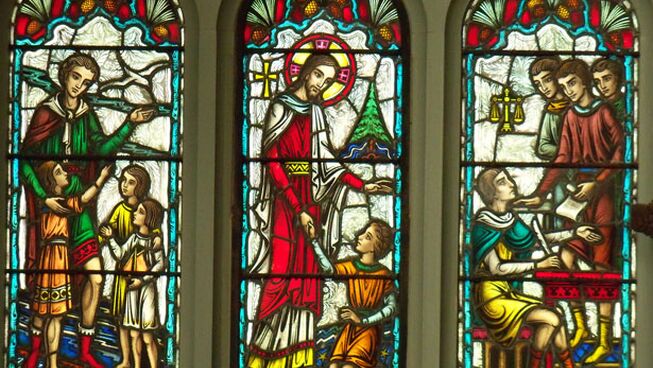Myth busters: Christianity!

When I was growing up (and some suggest that I still am), I went through a phase of loving all those ancient Greek myths - Hercules, Medusa, the Titans and others that have disappeared like wisps of cloud in my mind. In fact, I was reading them so long ago that it is hard to remember just how old I was, what I was doing at the time and why I was getting into them.
And that pretty much hits myths on the head. They are stories that might have some determinable basis of fact but now are no longer determinable, if they ever were. They are stories, characters or events that were invented at some point by someone and we’re not really sure when or why - but it doesn’t really matter. They are made up and in the case of legends so much time has passed we can’t know.
So does Christianity fall into this category? Is Jesus just a great big whopping myth?
What about if I told you that we can get within 5 years of Jesus’ death and know what the Christians thought about Jesus. Yes, that’s right - according to some hard work that a bunch of historians (not mythologists) have done we can know what Christians thought about Jesus within 5 years of his life and death. I hope you’ll admit that it might be hard work to get a really good myth going in just 5 years.
To prove my bold statement of 5 years let me show you the method the historians used and then let me show you what the early Christians thought about Jesus.
The method of historians
Sceptical scholars - scholars with degrees and doctorates who are not Christian - see certain parts of the Bible as valid and reliable historical documents. They don’t treat the Bible as inspired or the whole set of books as trustworthy, but they do treat certain parts of the Bible as valid, reliable critical source documents for history.
One part of these valid, reliable historical sources are the writings of the Apostle Paul. The New Testament includes 13 letters written by Paul. Sceptical scholars accept that six or seven of these were written by Paul. Unanimously, they accept:
- Paul’s letter to the Philippians (Philippians)
- His first letter to the Thessalonians (1 Thessalonians)
- His letter to the Christians in Rome (Romans)
- His first and second letter to the Corinthians (1 and 2 Corinthians)
- And finally, Paul’s letter to the Galatians (Galatians).
Scholars treat these as reliable historical documents because Paul is an authoritative source. He has critical mind, he was in the right place at the right time, he knows the other people who were in the right place at the right time and scholars have clearly established who he is.
Using just the writings of Paul in 1 Corinthians and Galatians we can know what the Christians believed about Jesus within 5 years of Jesus death. 1 Corinthians provides the content and Galatians provides the critical timeline:
| 30 AD | Jesus died. |
| 32 AD | Paul was converted on the road to Damascus. |
| 35 AD |
In 35 AD Paul very probably received what he taught the Corinthians. We know this from Galatians 1:18 1: “Then after three years, I went up to Jerusalem to get acquainted with Peter and stayed with him fifteen days.” Paul was converted in 32 AD. Three years later he went to Jerusalem to be acquainted with Peter. However, the word acquainted doesn’t quite capture the meaning here. It is more like the word interview or gathering eyewitness news. Paul went to interview Peter. He stayed with him and also met with James. Given Paul’s use of the technical word received, this is the most probable time for when Paul received the creed of 1 Corinthians 15. We also know that Paul was teaching the same thing from 35 AD to 49 AD. Fourteen years after visiting, Paul returned to Jerusalem in 49 AD and checked with the apostles what he was teaching. He got a thumbs up from the leaders: “Those, I say, who seemed influential added nothing to me.” (Galatians 2:1-6). |
| 51-52 AD |
Paul visited Corinth in 51-52 AD. We know Paul visited Corinth around this time because of two things:
When Paul was in Corinth in 51 AD, he taught the Corinthians what he had received from the apostles: “For I delivered to you as of first importance what I also received“ (1 Corinthians 15:3). This is even more significant when you know that the words received and delivered are technical Rabbinic words for formal teaching and explaining. This was no casual conversation. |
| 57-58 AD |
In 57-58 AD Paul writes the first letter to the Corinthians. In chapter 15, Paul lays out what he taught them when he was in Corinth. “Now I would remind you, brothers, of the gospel I preached to you, which you received” (1 Corinthians 15:1). He then goes onto lay out the gospel with them. We’ll get to that. At the end of this section, Paul shows that what he just said is the bona fide version of the church: "Whether then it was I or they (the other apostles), so we preach and so you believed" (1 Corinthians 15:11). In other words, Paul is saying “The other apostles and I teach and preach the same thing. If you don’t like me and what I say, go talk to apostle Peter or talk to James. You’ll get the same answer.” |
As you can see, Paul received the formal teaching in 35 AD. This was within five years of Jesus’ death. However, there is a further dimension here. What Paul received was an already formalised creed from before 35 AD. The rhyming structure of the creed is the give-away here. The creed was written to be easy to repeat and memorise in ancient Greek. So, we are look back to even before 35 AD.
This pretty much knocks the whole myth concept on the head. Paul tells us what he was told and when he was told it. If we lived at the time we could have gone and checked with the people he conferred with in the churches in Corinth, Damascus and Galatia.
So, what is it that the Christians believed about Jesus before 35 AD?
“For I delivered to you as of first importance what I also received: that Christ died for our sins in accordance with the Scriptures, that he was buried, that he was raised on the third day in accordance with the Scriptures, and that he appeared to Cephas, then to the twelve. Then he appeared to more than five hundred brothers at one time, most of whom are still alive, though some have fallen asleep. Then he appeared to James, then to all the apostles.” (1 Corinthians 15:3-7)
In short:
- Jesus Christ died for our sins. He wasn’t an example and he wasn’t a martyr.
- Jesus was buried. Jesus really did die, he didn’t faint or pretend to be dead.
- Jesus came back from the dead three days later. He was resurrected.
- Cephas (also called Simon Peter) saw the resurrected Jesus himself.
- All the twelve apostles together saw the resurrected Jesus.
- This all happened just as their Scriptures (our Old Testament) laid out. The prophecies stated in the Old Testament have been fulfilled.
References
For more information, have a look at the sources I used for this article:
You Tube:
The Resurrection argument that changed a generation of scholars
https://www.youtube.com/watch?v=ay_Db4RwZ_M
The short version:
Habermas, GR & Licona, MR (2004) The Case for the Resurrection of Jesus, US: Kregel Publications
The big, thick and serious version:
Habermas, GR (1996) The Historical Jesus: Ancient Evidence for the Life of Christ, College Press Publishing Company.
Murphy-O'Connor, J (2002) St. Paul's Corinth: Texts and Archaeology, Liturgical Press.
1 See Page 160-162 of St. Paul's Corinth: Texts and Archaeology by Jerome Murphy-O'Connor .
2 Another historian Paul Barnett posits that Paul may have received this teaching in Damascus, rather than Jerusalem, which would make the timing even earlier than 35 AD. But let’s just stick with 35 AD for now.





